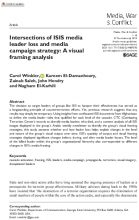The decision to target leaders of groups like ISIS to hamper their effectiveness has served as a longstanding principle of counterterrorism efforts. Yet, previous research suggests that any results may simply be temporary. Using insights from confiscated ISIS documents from Afghanistan to define the media leader roles that qualified for each level of the cascade, CTC (Combating Terrorism Center) records to identify media leaders who died, and a content analysis of all ISIS images displayed in the group’s Arabic weekly newsletter to identify the group’s visual framing strategies, this study assesses whether and how leader loss helps explain changes in the level and nature of the group’s visual output over time. ISIS’s quantity of output and visual framing strategies displayed significant changes before, during, and after media leader losses. The level of the killed leader within the group’s organizational hierarchy also corresponded to different changes in ISIS’s media framing.
